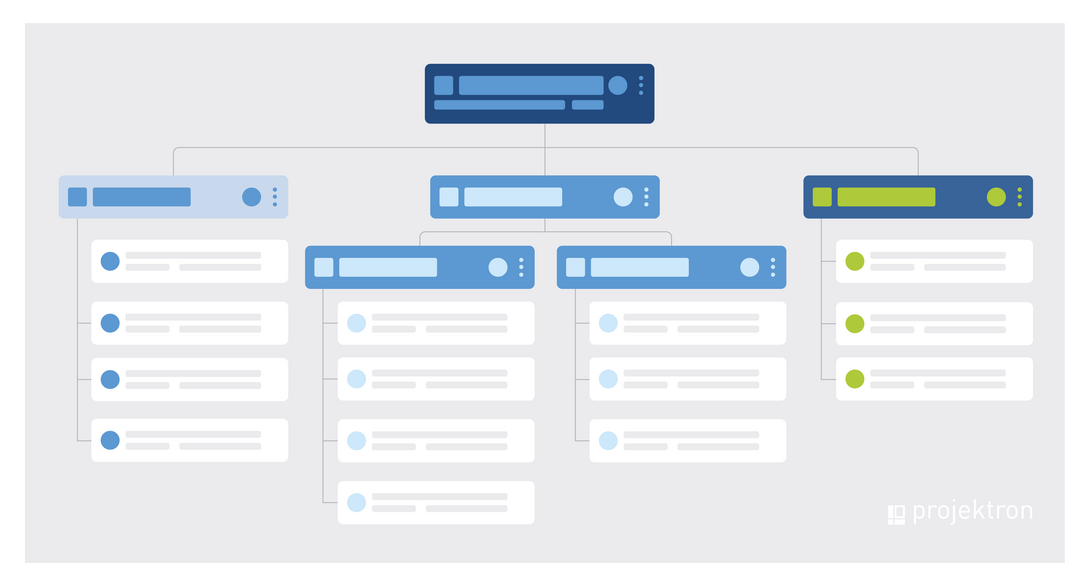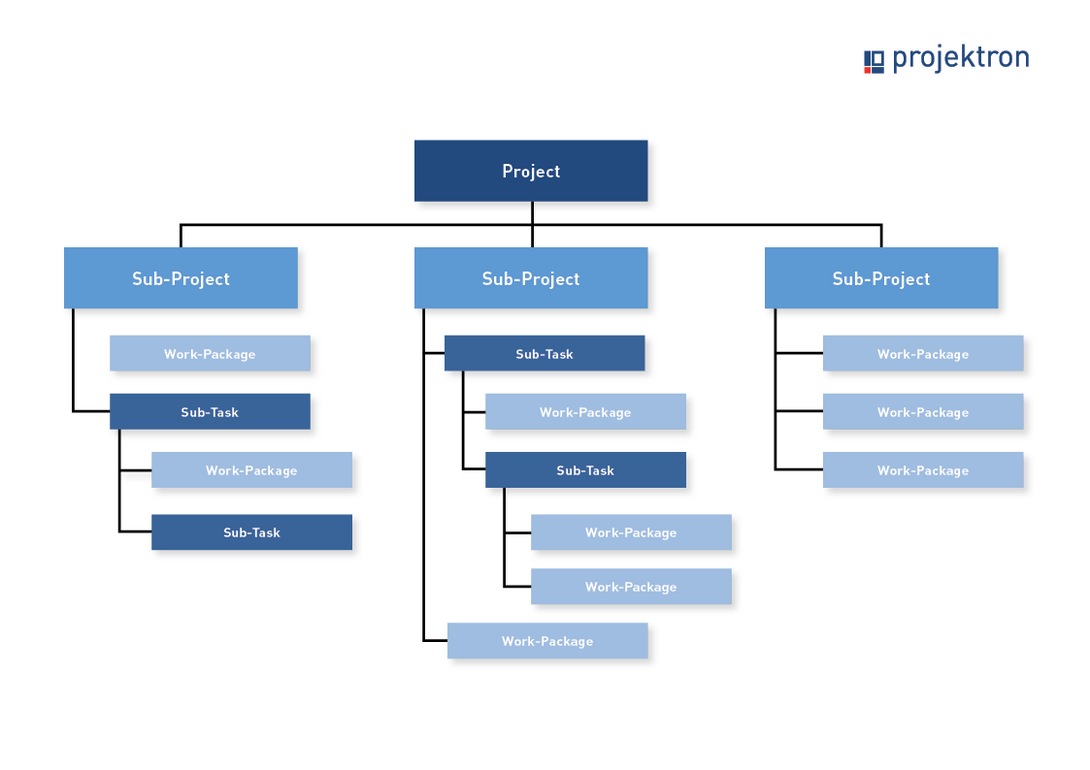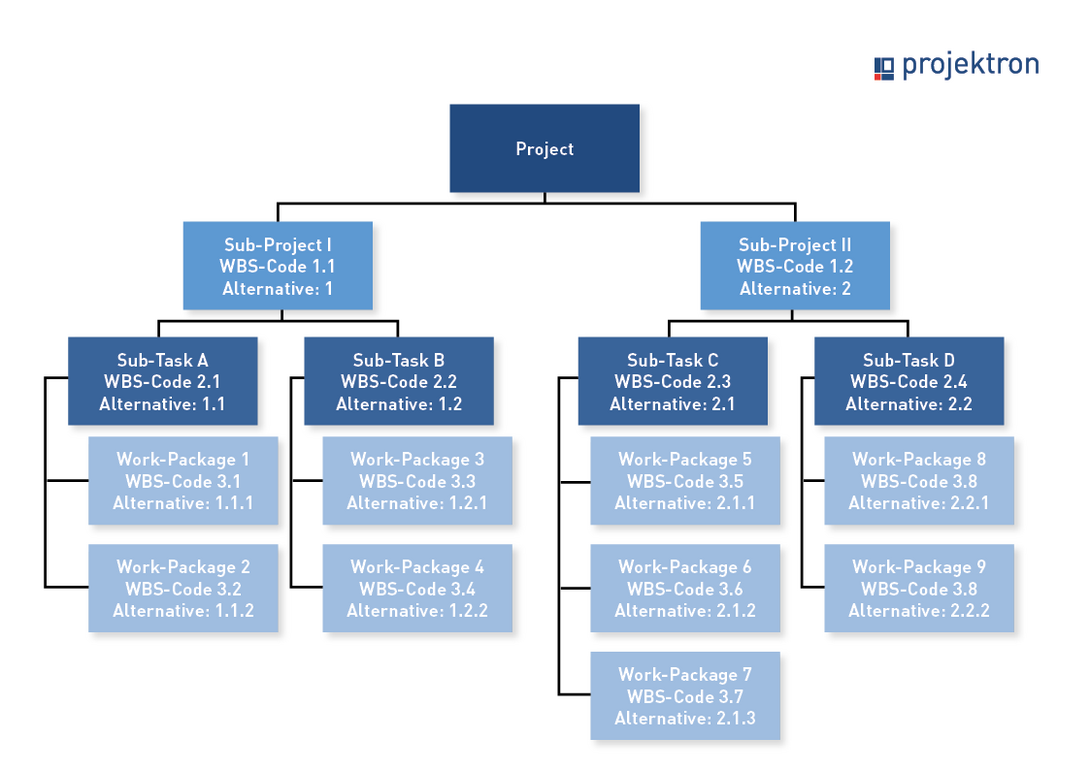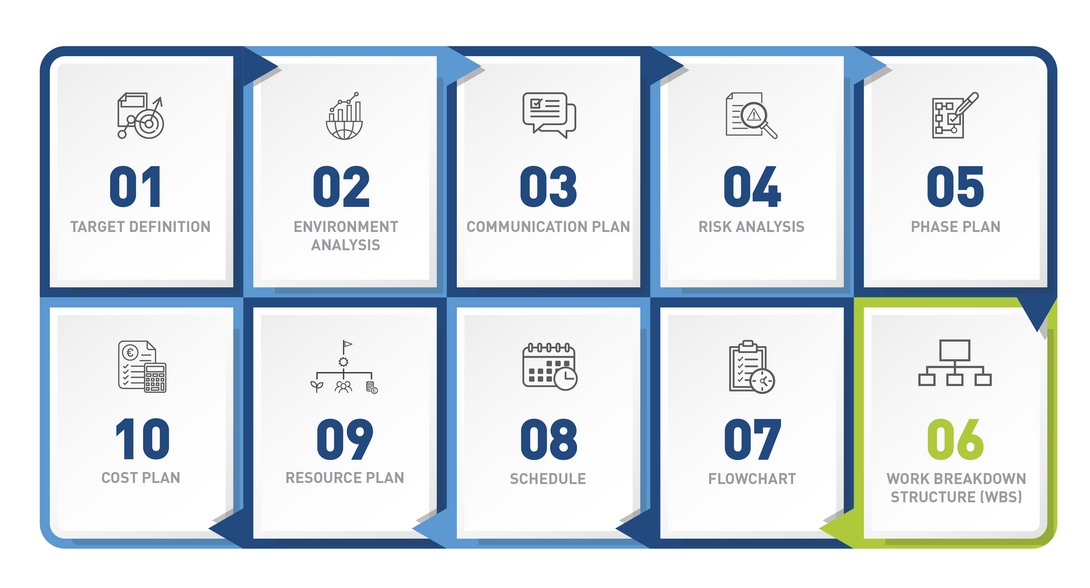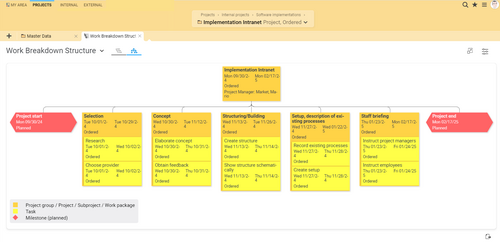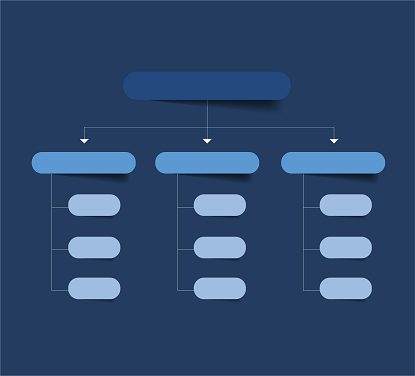01/02/2024 - Articles
Creating a work breakdown structure: the plan of plans in project management
It is considered the plan of plans or the mother of all plans in classic project management: the work breakdown structure (WBS). The WBS is an elementary component of the project plan and is used to define the complete scope of a project and present it in a structured manner. You can find out what you should bear in mind and how you should proceed when creating a work breakdown structure here.
Contents:
- Definition: What is a work breakdown structure?
- What does a work breakdown structure look like?
- When should the work breakdown structure be created?
- Why create a work breakdown structure?
- Creating a work breakdown structure: 6 tips
- Is it possible without a work breakdown structure?
- Work breakdown structure and other work breakdown structures
- Structural planning in Projektron BCS
- Conclusion: A structured start
Definition: What is a work breakdown structure?
The work breakdown structure (WBS) is also known as the mother of all plans in project management. It provides a structured representation of the content of the entire project. It forms the basis for all other planning steps and plans that are created according to it.
DIN 69901-5:2009-1 "Project management - Project management systems - Part 5: Terms" defines four terms relating to project structure and WBS as follows:

Definitions according to DIN 69901-5:2009-1
3.79 Project structure: The totality of all elements (sub-projects, work packages, activities) of a project and the essential relationships between these elements.
3.80 Level of project structure: Organizational level within the work breakdown structure
3.81 Project structuring: Definition and logical organization of the elements (sub-projects, work packages, activities) according to various possible aspects as well as the organizational and process structure of a project
3.82 Work breakdown structure (WBS): Complete, hierarchical representation of all elements (sub-projects, work packages) of the project structure as a diagram or list. NOTE: Each superordinate element must be fully described by its subordinate elements. The smallest element of the work breakdown structure is the work package.
The task of the WBS is therefore only to fully depict the project structure. It is the graphical representation of the project's scope of delivery and services. The WBS is therefore about WHAT needs to be done. It does not provide any information about the time sequence of the individual activities, their duration or even start and finish dates.
The project object is subdivided hierarchically in the work breakdown structure into sub-projects, sub-tasks and work packages. The aim is to structure the project into manageable and delegable units (work packages), on the basis of which effort can be estimated, resources allocated and schedules created in the next step. Unambiguous coding ensures clear identification of the elements.
What does a work breakdown structure look like?
The DIN standard does not specify a particular form of presentation ("diagram or list"). However, a structured representation in a tree structure offers a much better overview than a simple representation of all work packages as a mere list. In classic, traditional project management, the work breakdown structure is therefore usually presented as a tree structure.
The project (root element in the work breakdown structure) is subdivided into sub-projects for rough structuring.
Subtasks can be used to subdivide subprojects.
Work packages are used to subdivide subprojects and subtasks, are easy to define, manage and delegate and are the smallest element in the WBS.
How detailed does the work breakdown structure need to be?
A work breakdown structure can be expressed up to any level. Three project structure levels are the recommended minimum. The lowest element in a tree structure that is not further subdivided is called a terminal element. In the work breakdown structure, these are usually the work packages.
Work packages describe self-contained and delegable tasks. A work package at task level is a task that:
can be realistically and reliably estimated.
makes no practical sense to break down further.
delivers a result that can be measured.
could be outsourced or commissioned.
To answer the question, "When is the planning detailed enough?" there are various rules of thumb. The "80-hour rule", for example, states that no activity at the lowest hierarchical level should require more than 80 hours of effort. Another rule is that no activity or group of activities should be planned for longer than a single reporting period. In addition to such rules, common sense and personal experience are of course generally useful.
What belongs in the work breakdown structure?
In addition to clearly naming each task, it is advisable to establish a coding scheme that facilitates the orientation and assignment of individual tasks to superordinate project structure levels. There is no standard for coding in the work breakdown structure. It should be selected according to suitable project-related criteria. It should be immediately recognizable on which level in the work breakdown structure an element is located and to which structural element this element is subordinate and superordinate.
In the case of more extensive project structures that comprise more than three structural levels in the WBS, it makes sense not to rely on your own word creations such as "main work package", "sub-work package", "sub-work package" or similar, but to provide each project structure element with a unique coding, the so-called work breakdown structure code (WBS code). In most cases, alphanumeric coding with consecutive numbering proves to be sufficient, e.g.
Root element (project name): 1
Sub-projects: 1.1, 1.2, 1.3, 1.4 and 1.PM
Work packages: 1.1.1, 1.1.2, 1.2.1, 1.2.2, 1.2.3, 1.4.1, 1.4.2, 1.PM.1, 1.PM.2, etc
A coding scheme also helps to recognize elements in any written context and enables assignment to the glossary.
Orientations - What project structures are there?
There are four different structuring options and therefore four different ways of orienting a work breakdown structure:
Object-oriented
An object-oriented work breakdown structure is based on objects, for example delivery objects, parts, assemblies or components. The designation of the sub-projects answers the question: "What is being created?" An object-oriented work breakdown structure specifies results, not the methods or concrete paths that lead to them. This orientation is therefore particularly suitable if you expect your project team to be creative and find their own solutions.
Activity orientation / function orientation
An activity-oriented work breakdown structure is based on activities that need to be completed as part of the project. The name of the sub-projects answers the question: "What needs to be done?" The result, on the other hand, is usually less clearly defined. For function-driven software projects, the very similar technique of the functional breakdown structure can therefore be used.
Phase orientation
The phase-oriented work breakdown structure is organized by phase in the first project structure level below the root element (e.g. concept, development, commissioning). Below this level, the subtasks and work packages are then structured either object-oriented or activity-oriented.
Mixed orientation
The mixed-oriented work breakdown structure combines different orientation principles. However, only one structuring principle may be used for each project structure level of the WBS (e.g. objects on the 1st structuring level, activities on the 2nd structuring level).
The orientation of the work breakdown structure has no influence on how it can be displayed. All orientations can be displayed both as a tree structure and as a structured table.
When should the work breakdown structure be created?
The work breakdown structure is created during the planning phase of a project. It is therefore part of the project plan, as are the previously carried out definition of project objectives, project environment analysis with stakeholder and risk analysis and the communication plan.
The work breakdown structure is ideally created by the project manager during the project planning phase in the form of a workshop involving a well-chosen group of participants. Experience and technical expertise are crucial in order to be able to define all the necessary work packages. In practice, the brainstorming or mind mapping method is suitable for this.

It makes sense to create the work breakdown structure as part of a joint kick-off meeting at the start of the project or to discuss a draft plan together. The prerequisite is that the most important milestones and project phases have already been defined and the project goals have been formulated in accordance with the SMART criteria.
Project structure planning plays a central role in project planning, as it can act as a link between rough planning steps and detailed planning. All subsequent planning steps are based on the WBS, namely the flow plan, the project timetable, the resource plan and the cost plan. As part of task or structural planning, the work breakdown structure defines the tasks to be completed in the project, i.e. the "WHAT", the subject of the project.
Why create a work breakdown structure?
The effort involved in creating a work breakdown structure is worthwhile in many ways:
- Complete representation ensures a uniform understanding of all project deliveries and services, including project management efforts
- Determination of all work packages (cost units) belonging to the project
- Organize and structure the work packages in a suitable system (cost unit structure)
- Good basis for communication, as it is understandable for all stakeholders
- Basis for common terminology
- Basis for delegating and defining responsibilities (e.g. sub-project managers for sub-projects and work package managers)
- Specification of a structure for all project management tasks (planning, controlling, monitoring)
- Basis for structuring all project documents (specifications, reports, etc.)
- Basis for all further plans
In traditional project management, the detailed planning of your project begins with the work breakdown structure.
Creating a work breakdown structure: 6 tips
Project management tasks should always be created as a separate sub-project in the work breakdown structure, regardless of how the WBS is structured. This makes sense in order to record the effort and responsibilities for these activities, which accompany the project throughout its entire duration.
If the WBS becomes too extensive with too many subdivisions and work packages, it is advisable to create several additional structure plans for each sub-project. An excessive level of detail reduces clarity and increases the workload disproportionately. The use of project management software is recommended in order to maintain an overview even with complex project structures.
When coding sub-projects, sub-tasks and work packages, a uniform coding scheme should be used, regardless of the form in which you have drawn up your work breakdown structure.
Adhere to the 100% rule. This means that the work breakdown structure covers 100% of the project scope, i.e. all deliverables (internal, external and interim results), including project management. The sum of the breakdown structure elements at a lower level must cover 100% of the higher project structure level. Work that is not part of the agreed project scope therefore has no place in the work breakdown structure. The rule applies down to the level of individual tasks/activities. Their total must account for 100% of the work required to complete a work package.
Make sure that there is no overlap or even duplication when defining the scope of different elements of the work breakdown structure. Duplication of work, misunderstandings, unclear responsibilities and authorities as well as errors in project costing would be possible consequences. In the work breakdown structure glossary, clearly define which element of the work breakdown structure consists of exactly which services, activities, deadlines and resources.
For phase-oriented work breakdown structures, you should ensure that the phases are clearly separated from each other by a clearly defined result that is also used in the definition of entry and exit criteria (e.g. a design review).
Do you need a work breakdown structure or can you do without one?
In practice, the work breakdown structure planning method is often neglected. This may be due to the fact that work breakdown structures are often not implemented as standard in project management software and the focus there is primarily on scheduling using Gantt charts.
In simple projects for which a detailed functional specification already exists, the development of a work breakdown structure may actually be superfluous. However, the prerequisite is that the project content has been recorded in some structured form. However, the creation of a complete work breakdown structure (project or product structure plan), which represents the scope of the project, is mandatory when implementing projects according to PM standards.
In a larger project, the work breakdown structure is essential. It helps to visualize the concrete scope of services and designates responsibilities. In addition, the WBS assigns codes for the various activities. Work breakdown structures are also ideal for presenting the project scope completely and clearly, without immediately mapping the additional complexity levels of time and resource planning. The work breakdown structure offers the ideal opportunity to fully grasp the project content for the first time by breaking down the complex project into more manageable tasks.
Work breakdown structure and other structure plans
The term work breakdown structure is often equated with other terms. Let's take a closer look at the differences!
Project structure and process structure
The project structure, shown in the work breakdown structure, must be clearly distinguished from the flow plan, shown in the flowchart. They are often used almost synonymously, as many project management software products handle both planning steps together in one view or with one functionality. Both planning steps are part of the project planning phase, but project structure planning precedes flow planning. The flowchart, usually presented as a Gantt chart, breaks down the chronological sequence and dependency structure of the activities previously defined in the work breakdown structure.
Work breakdown structure and product breakdown structure
The PRINCE2® project management standard recommends the creation of a work breakdown structure instead of a work breakdown structure. If the work breakdown structure has a consistent object-oriented structure, the product breakdown structure and work breakdown structure can be mapped to each other.
Work breakdown structure and story map
In agile managed projects according to Scrum, the story map corresponds to the work breakdown structure. A story map structures the product backlog according to epics and user stories.
Work breakdown structure and work breakdown structure (WBS)
The work breakdown structure is a planning element defined in the IPMA/GPM standard for project management. The PMBOK® Guide, which defines project management according to PMI, also describes the work breakdown structure (WBS). The WBS focuses on structuring according to work processes and partial results. A deliverable must also be defined for each work package.
Work breakdown structure planning in Projektron BCS
If you want to create a work breakdown structure, you should use professional project management software. You can also create informative work breakdown structures in MS Excel, MS PowerPoint or special mind map, diagram or table software. However, comprehensive project management software allows you to record all the necessary information centrally, make changes and additions at any time and at the same time provides the data basis for carrying out the remaining project planning steps directly.
In the "Structure plan" view, the Projektron BCS project management software displays projects in a hierarchical tree structure of project structure elements of any depth. Here you can not only view, edit and filter the structure of your project consisting of sub-projects, work packages, milestones and tasks, but you also have the option of specifying the duration of processing for each task directly for the subsequent process planning. You can define or change the order of the structural elements simply by dragging and dropping.
In the "Organizational chart" sub-view, you can also display your work breakdown structure in BCS as an organizational chart. The color and shape of an organizational chart element provide information about the type and status of the displayed project structure element. The colors of the organizational chart correspond to the subsequent colors of the bars in the Gantt chart. Clicking on a project structure element in the organization chart takes you directly to the master data of the respective element.
Use the comprehensive project planning functions of Projektron BCS to automate your planning processes, reduce planning effort and avoid errors - no matter which project management method you use. See for yourself and test Projektron BCS now, free of charge and without obligation.
Conclusion: A structured start with the work breakdown structure
The work breakdown structure (WBS) is a key tool in traditional project management for defining the scope of a project and presenting it in a structured manner. It forms the basis for all further planning steps and plans. A well-prepared WBS offers numerous advantages, such as a uniform understanding of the project, a good basis for communication for all stakeholders, the possibility of defining and delegating responsibilities and structuring all project management tasks.
When creating a WBS, there are a few tips to keep in mind, such as including project management tasks as a separate sub-project, avoiding excessive detail, using a consistent coding scheme and adhering to the 100% rule to cover the entire project scope. It is also important to avoid overlap and duplication when defining the scope and to set clear deliverables for individual phases.
Although project structure planning is sometimes neglected in practice, the effort involved in creating a WBS is worthwhile in many respects. It provides a solid basis for planning and controlling a project, promotes a common understanding and supports effective collaboration between all parties involved. Use Projektron BCS to easily create a clear work breakdown structure that supports the success of your project.

About the author
Like all other departments at Projektron GmbH, the marketing department also uses the possibilities of Projektron BCS project management software to deploy its resources in a targeted manner and implement projects efficiently. Kai Sulkowski is an editor in the marketing department, certified according to IPMA and always informed about the latest developments and innovations in the world of project management.
